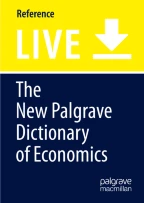Personnel Economics

Personnel economics is the application of economic and mathematical approaches and econometric and statistical methods to traditional questions in human resources management. Many of the issues studied by personnel economists can be found in traditional textbooks written by organizational behaviour scholars and other human resources specialists. Economists have something new to say about these issues, however, primarily because economics provides a rigorous, and in many cases more straightforward, way to think about these human resources questions than do the more sociological and psychological approaches.
This chapter was originally published in The New Palgrave Dictionary of Economics, 2nd edition, 2008. Edited by Steven N. Durlauf and Lawrence E. Blume.
Much of this article is excerpted from a larger overview on personnel economics in R. Gibbons and J. Roberts (eds), Handbook of Organizational Economics , Princeton: Princeton University Press, 2008.
This is a preview of subscription content, log in via an institution to check access.
Access this chapter
Similar content being viewed by others

Personnel Economics
Chapter © 2018

Organizational Psychology and the Rise of Human Resource Management
Chapter © 2020

Organizational Psychology and the Rise of Human Resource Management
Chapter © 2020
Bibliography
- Akerlof, G. 1984. Gift exchange and efficiency wage theory: Four views. American Economic Review 74: 79–83. Google Scholar
- Bergson, A. 1978. Managerial risks and rewards in public enterprises. Journal of Comparative Economics 2: 211–225. ArticleGoogle Scholar
- Cheung, S.N.S. 1969. The theory of share tenancy: With special application to Asian agriculture and the first phase of Taiwan land reform. Chicago: University of Chicago Press. Google Scholar
- Drago, R., and G.T. Garvey. 1998. Incentives for helping on the job: Theory and evidence. Journal of Labor Economics 16: 1–25. ArticleGoogle Scholar
- Ehrenberg, R.G., and M.L. Bognanno. 1990. Do tournaments have incentive effects? Journal of Political Economy 98: 1307–1324. ArticleGoogle Scholar
- Eriksson, T. 1999. Executive compensation and tournament theory: Empirical tests on Danish data. Journal of Labor Economics 17: 262–280. ArticleGoogle Scholar
- Eriksson, T., and M.-C. Villeval. 2004. Other-regarding preferences and performance pay. An experiment on incentives and sorting. Discussion Paper No. 1191, Institute for the Study of Labor (IZA), Bonn. Google Scholar
- Falk, A., and E. Fehr. 2006. The power and limits of tournament incentives. Mimeo: University of Bonn. Google Scholar
- Fernie, S., and D. Metcalf. 1999. It’s not what you pay it’s the way that you pay it and that’s what gets results: Jockeys’ pay and performance. Labour 13: 385–411. ArticleGoogle Scholar
- Gibbons, R. 1987. Piece-rate incentive schemes. Journal of Labor Economics 5: 413–429. ArticleGoogle Scholar
- Goldin, C. 1986. Monitoring costs and occupational segregation by sex: A historical analysis. Journal of Labor Economics 4: 1–27. ArticleGoogle Scholar
- Hölmstrom, B. 1979. Moral hazard and observability. Bell Journal of Economics 10: 74–91. ArticleGoogle Scholar
- Hutchens, R.M. 1986. Delayed payment contracts and a firm’s propensity to hire older workers. Journal of Labor Economics 4: 439–457. ArticleGoogle Scholar
- Hutchens, R.M. 1987. A test of Lazear’s theory of delayed payment contracts. Journal of Labor Economics 5: S153–S170. ArticleGoogle Scholar
- Hutchens, R.M. 1989. Seniority, wages and productivity: A turbulent decade. Journal of Economic Perspectives 3(4): 49–64. ArticleGoogle Scholar
- Ichniowski, C., K. Shaw, and G. Prennushi. 1997. The effects of human resource management practices on productivity. American Economic Review 86: 291–313. Google Scholar
- Ichniowski, C., K. Shaw, and W. Boning. 2001. Opportunity counts: Teams and the effectiveness of production incentives. Working Paper No. 8306. Cambridge, MA: NBER. Google Scholar
- Ichniowski, C., K. Shaw, and A. Bartel. 2007. How does information technology really affect productivity? Plant-level comparisons of product innovation, process improvement and worker skills. Quarterly Journal of Economics (forthcoming). Google Scholar
- Jensen, M.C., and J.M. Kevin. 1990. Performance pay and top management incentives. Journal of Political Economy 98: 225–264. ArticleGoogle Scholar
- Johnson, D.G. 1950. Resource allocation under share contracts. Journal of Political Economy 58: 111–123. ArticleGoogle Scholar
- Kahneman, D., and A. Tversky. 1979. Prospect theory: An analysis of decision under risk. Econometrica 47: 263–291. ArticleGoogle Scholar
- Knoeber, C.R. 1989. A real game of chicken: Contracts, tournaments, and the production of broilers. Journal of Law, Economics & Organization 5: 271–292. Google Scholar
- Lazear, E.P. 1986. Salaries and piece rates. Journal of Business 59: 405–431. ArticleGoogle Scholar
- Lazear, E.P. 2000a. Performance pay and productivity. American Economic Review 90: 1346–1361. ArticleGoogle Scholar
- Lazear, E.P. 2000b. Economic imperialism. Quarterly Journal of Economics 115: 99–146. ArticleGoogle Scholar
- Lazear, E.P. 2000c. The future of personnel economics. Economic Journal 110: F611–F639. ArticleGoogle Scholar
- Lazear, E.P., and S. Rosen. 1981. Rank-order tournaments as optimum labor contracts. Journal of Political Economy 89: 841–864. ArticleGoogle Scholar
- Marshall, A.P. 1890. Principles of economics, 9th ed, with annotations by C.W. Guillebaud. London/New York: Macmillan, for the Royal Economic Society, 1961. Google Scholar
- Oyer, P. 2004. Why do firms use incentives that have no incentive effects? Journal of Finance 59: 1619–1649. ArticleGoogle Scholar
- Oyer, P., and S. Schaefer. 2005. Why do some firms give stock options to all employees: An empirical examination of alternative theories? Journal of Financial Economics 76: 99–133. ArticleGoogle Scholar
- Paarsch, H.J., and B. Shearer. 1999. The response of worker effort to piece rates. Journal of Human Resources 34: 643–667. ArticleGoogle Scholar
- Ross, S.A. 1973. The economic theory of agency: The principal’s problem. American Economic Review 63: 134–139. Google Scholar
- Russell, K. 2005. Deferred compensation and employee retention. Ph.D. thesis, Department of Economics, Stanford University. Google Scholar
- Shapiro, C., and J.E. Stiglitz. 1984. Equilibrium unemployment as a worker discipline device. American Economic Review 74: 433–444. Google Scholar
- Stiglitz, J.E. 1975. Incentives, risk, and information: Notes toward a theory of hierarchy. Bell Journal of Economics and Management Science 6: 552–579. ArticleGoogle Scholar
Author information
- http://link.springer.com/referencework/10.1057/978-1-349-95121-5 Edward Lazear
- Edward Lazear

